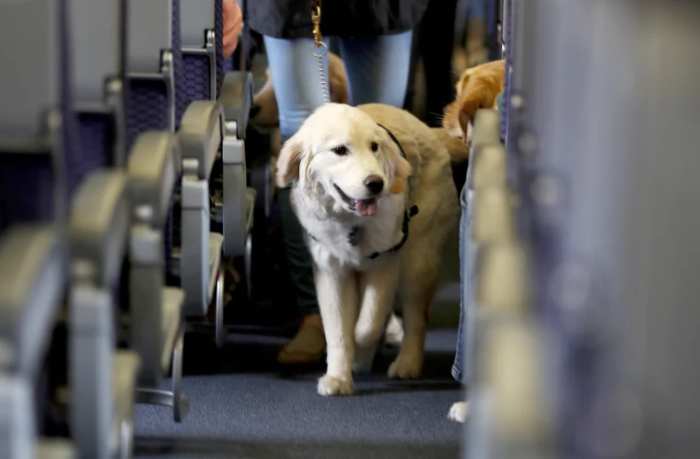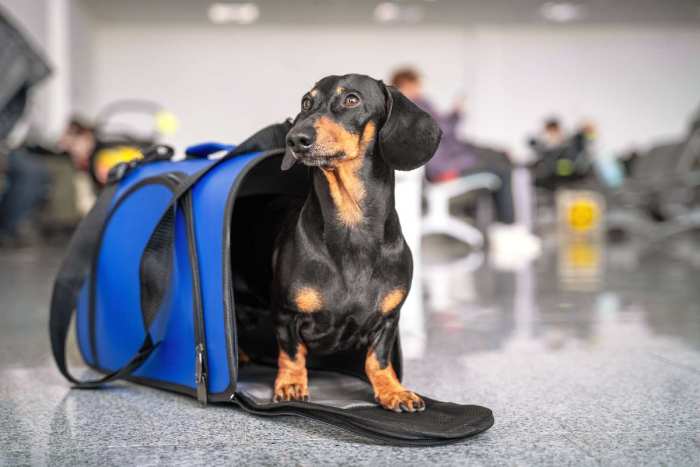Are Dogs Allowed on Planes? Flying with your furry friend can be daunting, especially if you’re unsure about the rules and regulations surrounding pets on planes. As a seasoned traveler and dog lover, I understand the importance of having all the information you need to ensure a smooth and stress-free journey for you and your canine companion.
In this article, I’ll provide the essential details about are dogs allowed on planes, the requirements you need to meet, and any additional tips to make your travel experience as comfortable as possible. So, buckle up and get ready to embark on a journey of discovery that will help you navigate the skies with your four-legged friend by your side.
You may wonder if bringing your dog on a plane is even allowed. Well, the good news is that many airlines do allow dogs on board, but there are certain guidelines and restrictions that you need to be aware of. From breed restrictions to size limitations, it’s crucial to understand the specific policies of the airline you’ll be flying with.
In this article, I’ll break down the rules and regulations for traveling with dogs on planes so you can make an informed decision and plan your trip accordingly. So, let’s dive into the world of pet-friendly airlines and explore the possibilities of flying with your furry friend.
Are Dogs Allowed on Planes?
When traveling with our furry friends, many may wonder, “Are dogs allowed on planes?” The answer is, generally, yes. However, certain rules and regulations must be followed to ensure a smooth and stress-free journey for you and your canine companion.

First and foremost, it’s important to understand that each airline has its policies regarding traveling with pets. Some airlines allow dogs in the cabin, while others require transporting them in the cargo hold. It’s crucial to familiarize yourself with the specific guidelines of the airline you will be flying with.
Here are a few key points to consider when traveling with your dog on a plane:
- Size and breed restrictions: Some airlines restrict the size and breed of dogs in the cabin. Larger dog breeds may be required to travel in the cargo hold. It’s important to check with the airline beforehand to ensure your dog meets the requirements.
- Pet carrier specifications: If your dog is allowed in the cabin, they must be transported in an airline-approved pet carrier. These carriers should provide enough space for your dog to stand, turn around, and lie comfortably. Additionally, they should be well-ventilated and secure.
- Health and vaccination requirements: Most airlines require dogs to have a health certificate issued by a veterinarian, stating that they are in good health and up-to-date on their vaccinations. Visiting the vet before your trip is recommended to ensure your dog is in optimal health and meets all the requirements.
So, if you plan to bring your dog along on your next adventure, research, check the airline’s policies, and prepare accordingly. Traveling with your dog can be a wonderful experience if you’re well-prepared and informed.
Read More: Best Dog Friendly Beaches
Decoding Policies and Guidelines: Understanding Airline Regulations
When it comes to traveling with dogs on planes, it is crucial to understand the policies and guidelines set by the airlines. Each airline may have its rules and regulations regarding pet travel, so it is important to research and familiarize yourself with them before your trip.
Size and Breed Restrictions: Some airlines have restrictions on certain breeds of dogs or impose weight limits. Larger dogs may need to fly in the cargo hold, while smaller dogs may be allowed in the cabin. To ensure compliance, it’s important to check with the airline regarding their specific size and breed restrictions.
Health and Vaccination Requirements: To protect the health and well-being of all passengers, airlines typically require dogs to be in good health and up-to-date on their vaccinations. You may be asked to provide documentation of your dog’s health and vaccination records before boarding. Visiting your veterinarian before your trip is advisable to ensure your dog is in good health and meets all the requirements.
Additional Fees: Most airlines charge an additional fee for traveling with pets. The fees can vary depending on the airline and the type of pet travel. It is important to factor in these fees when budgeting for your trip.
Understanding the policies and guidelines surrounding traveling with dogs on planes is essential for a smooth and stress-free journey. By adhering to these rules, you can ensure the safety and comfort of both your furry friend and fellow passengers. Remember to check the specific policies of the airline you will be flying with, prepare accordingly, and have a fantastic trip with your canine companion.
Size Matters: Breed Restrictions and Size Limitations
Airlines have specific guidelines to ensure the safety and comfort of all passengers, including our four-legged companions. Here are some important points to keep in mind regarding breed restrictions and size limitations:
- Restricted Breeds: Some airlines have restrictions on certain breeds, either due to their aggressive reputation or potential health concerns. It’s crucial to check with the airline beforehand to see if your dog’s breed is allowed. Breeds commonly restricted include Pit Bulls, Rottweilers, Doberman Pinschers, and German Shepherds.
- Size Limitations: Airlines have size restrictions for dogs traveling in the cabin. Most airlines require that the dog comfortably fit in a carrier under the seat in front of you. This means larger breeds may have to travel in the cargo hold, where specific regulations and requirements apply. Check the airline’s website or contact customer service for precise size limitations.
- Certification and Documentation: In some cases, airlines may require additional certifications or documentation for certain breeds. This could include proof of training, behavior evaluations, or even a letter from a veterinarian stating that your dog is fit to travel. To avoid any last-minute surprises, you must familiarize yourself with these requirements.
- Pet Carrier Specifications: Regardless of breed restrictions or size limitations, all dogs traveling in the cabin must be kept in an airline-approved pet carrier. These carriers must be well-ventilated, leak-proof, and secure. The size of the carrier should also be appropriate for your dog’s comfort. Remember to label the carrier with your contact information.
- Additional Fees: It’s important to know that additional fees may be associated with traveling with your dog on a plane. These fees can vary depending on the airline and the destination. Check the airline’s pet policies for information on fees and payment methods.
Pre-flight Checklist: Requirements for Traveling with Dogs
Certain requirements must be met when traveling with dogs to ensure a smooth and hassle-free journey. As a responsible pet owner, it’s important to familiarize yourself with these requirements before heading to the airport.

1. Size and Breed Restrictions: Remember that different airlines have specific guidelines regarding the types and sizes of dogs allowed to travel. Some airlines may have breed restrictions due to safety concerns, especially for brachycephalic breeds like Bulldogs and Pugs. Additionally, there may be size limitations for dogs traveling in the cabin. It’s crucial to check with your airline beforehand to understand their policies.
2. Certification and Documentation: Certain breeds may require certification or documentation to ensure their safety and the safety of other passengers. Some airlines may ask for proof of vaccinations or even a health certificate issued by a veterinarian. Make sure to have all the necessary paperwork to avoid any last-minute complications.
3. Airline-Approved Pet Carrier: An airline-approved pet carrier is necessary when traveling with your dog. These carriers are designed to meet the airline’s size, ventilation, and security requirements. Choosing the right carrier that provides your furry friend with enough space to be comfortable during the journey is essential.
4. Additional Fees: It’s common for airlines to charge additional fees for traveling with pets. These fees can vary, so it’s important to check with your airline in advance to understand the cost implications. By being aware of additional fees, you can budget accordingly and avoid surprises at the check-in counter.
Understanding and meeting the requirements for traveling with dogs can ensure a hassle-free experience for yourself and your furry companion. Take the time to research and plan accordingly to enjoy your journey without any unnecessary stress or complications.
Tips for Ensuring a Comfortable Journey with Your Dog:
Traveling with your dog can be an exciting and rewarding experience. However, ensuring you and your furry friend are comfortable throughout the journey is important. Here are some tips to make your dog’s plane ride as pleasant as possible:
1. Choose the Right Carrier: Selecting the right carrier for your dog is crucial for their safety and comfort. Ensure it is airline-approved and meets the specific size requirements the airline sets. This will ensure your dog has enough space to move around and lie comfortably during the flight.
2. Familiarize Your Dog with the Carrier: It’s a good idea to get your dog accustomed to the carrier well before the travel date. Leave the carrier open at home and encourage your dog to explore and spend time in it. This will help reduce anxiety and make them more comfortable during the journey.
3. Pack Essentials: Just like you would pack essentials for yourself, bring everything your dog needs for the journey. This includes food, water, medication, toys, and necessary documents or health certificates. These readily available items will ensure that your dog’s basic needs are met throughout the trip.
4. Tire Out Your Dog Before the Flight: Before boarding the plane, engage your dog in physical exercise to help tire them. This will not only make them more relaxed during the flight, but it can also prevent excessive energy that could lead to restlessness or anxious behavior.
5. Comforting Familiar Objects: Bringing along familiar objects, such as their favorite blanket or toy, can give your dog security and comfort. These items can help alleviate stress and make them feel more at ease during the journey.
Conclusion:
Traveling with dogs on planes can be a smooth and enjoyable experience if you are well-informed and prepared. Understanding the rules and regulations set by each airline is crucial to ensure a hassle-free journey. Breed restrictions and size limitations are important factors to consider, as certain breeds may be restricted, and there are specific size requirements for dogs traveling in the cabin. It is essential to have the necessary certification and documentation for certain breeds.
Using an airline-approved pet carrier and being aware of any additional fees associated with traveling with a dog is necessary. To make the journey comfortable for your furry friend, choose the right carrier and familiarize your dog with it beforehand. Packing essentials, tiring out your dog before the flight, bringing comforting, familiar objects, and using calming techniques can all create a stress-free experience.
By following these tips and guidelines, you can ensure you and your dog have a pleasant trip. So, plan your next adventure with your four-legged companion, knowing you are well-prepared for a safe and comfortable journey.

Hey there, I’m Janet Brooks, a dog-loving student from California. I’m all about helping pups in need, especially those without homes. Me and my awesome friends work together to give shelter and love to stray dogs. Oh, and I also write blogs about dogs to share helpful info.